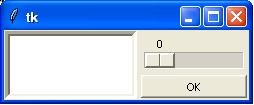Tkinter PanedWindow容器部件
一个PanedWindow是一个容器部件,可以包含任意数量的窗格,水平或垂直排列。
每个窗格包含一个窗口部件,每对窗格之间由可移动的(通过鼠标移动)分隔条分隔开。移动分隔条会导致分隔条两侧的窗口部件重新调整大小。
语法
以下是创建此部件的简单语法:
w = PanedWindow( master, option, ... )
参数
- master − 这代表父窗口。
-
options − 这是该小部件最常用的选项列表。这些选项可以用逗号分隔的键值对的形式使用。
| Sr.No | 选项& 描述 |
|---|---|
| 1 | bg 鼠标未悬停时滑块和箭头的颜色。 |
| 2 | bd 整个凹槽周围的3D边框宽度,以及箭头和滑块上的3D效果的宽度。默认情况下,凹槽周围没有边框,箭头和滑块周围有2像素边框。 |
| 3 | borderwidth 默认值为2。 |
| 4 | cursor 鼠标悬停在窗口上时显示的光标。 |
| 5 | handlepad 默认值为8。 |
| 6 | handlesize 默认值为8。 |
| 7 | height 没有默认值。 |
| 8 | orient 默认值为水平方向。 |
| 9 | relief 默认为平坦。 |
| 10 | sashcursor 无默认值。 |
| 11 | sashrelief 默认为凸起。 |
| 12 | sashwidth 默认值为2。 |
| 13 | showhandle 无默认值。 |
| 14 | width 没有默认值。 |
方法
PanedWindow对象具有以下方法:-
| 编号 | 方法与描述 |
|---|---|
| 1 | add(child, options) 将一个子窗口添加到分隔窗口中。 |
| 2 | get(startindex [,endindex]) 该方法返回指定字符或一段文本。 |
| 3 | config(options) 修改一个或多个小部件选项。如果没有给出选项,则该方法返回包含所有当前选项值的字典。 |
示例
尝试自己做以下示例。这里是创建一个3窗格小部件的方法 –
from tkinter import *
m1 = PanedWindow()
m1.pack(fill=BOTH, expand=1)
left = Entry(m1, bd=5)
m1.add(left)
m2 = PanedWindow(m1, orient=VERTICAL)
m1.add(m2)
top = Scale( m2, orient=HORIZONTAL)
m2.add(top)
bottom = Button(m2, text="OK")
m2.add(bottom)
mainloop()
当以上代码被执行时,会产生以下结果−

 极客教程
极客教程